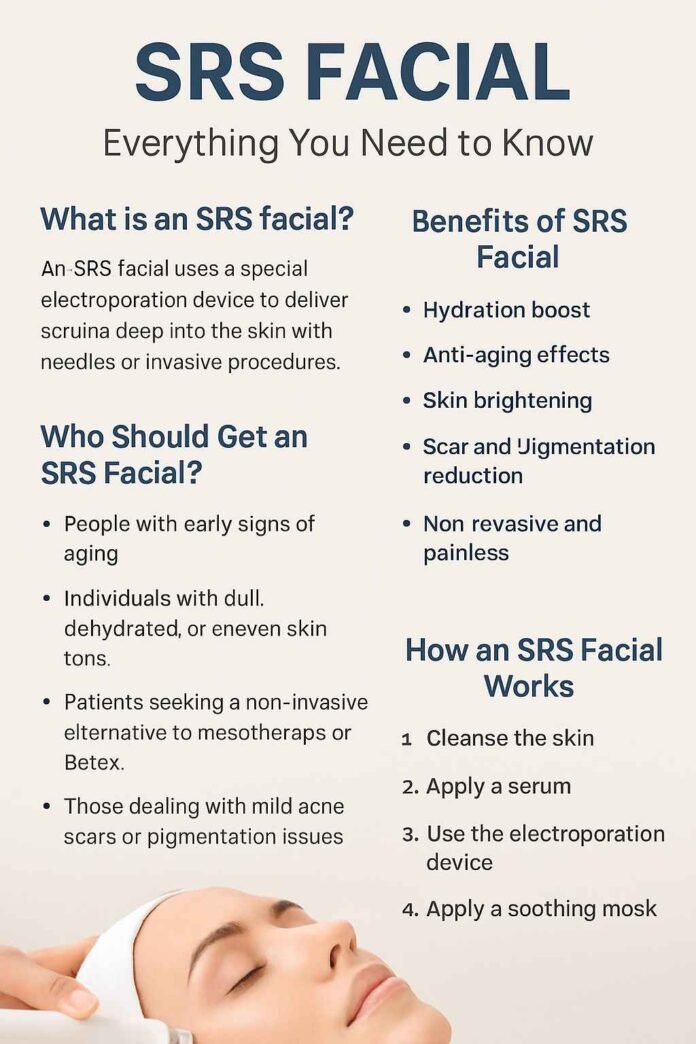The term SRS facial (Skin Rejuvenation System facial) is cropping up in clinics and on skincare menus because it promises visible improvement without needles, lasers, or long downtime. At its core it’s a transdermal delivery technique—often called electroporation facial or needle-free mesotherapy—that helps serums penetrate deeper than a standard spa facial. Below I’ll explain what it is, how it works, who it helps most, and what you should realistically expect. I’ll also question a few common assumptions so you can choose wisely.
Table of Contents
What is an SRS facial?
An SRS facial is a professional aesthetic treatment that uses short, controlled electrical pulses to temporarily increase the skin’s permeability so active ingredients — hyaluronic acid, peptides, vitamin C, antioxidants, and similar serums — can get past the outermost barrier. Unlike injections or microneedling, the device doesn’t puncture the skin; instead it creates transient pathways in the cell membrane (a process often called electroporation) that allow larger molecules to enter the epidermis and superficial dermis.
Think of it as a targeted delivery system: the goal is better absorption of potent serums and, indirectly, improved hydration and skin texture. It’s marketed as a gentle alternative to invasive procedures, but that doesn’t mean it’s a universal fix—read on to see where it fits best.
How the SRS facial works (stepwise overview)
- Consultation & skin assessment – A clinician evaluates skin type, concerns, allergies, and any contraindications (for example, implanted electronic devices or active infections).
- Cleansing and preparation – The face is thoroughly cleansed; exfoliation is sometimes performed to remove dead surface cells so serums penetrate more evenly.
- Serum selection – Based on goals (hydration, brightening, anti-aging, scar reduction), the practitioner applies a tailored serum cocktail—common ingredients include hyaluronic acid, peptides, and vitamin complexes.
- Electroporation treatment – The SRS device is applied across treatment zones. Electrical pulses produce a mild tingling sensation while creating temporary micro-channels in cell membranes that improve serum uptake.
- Soothing and protection – After treatment, a calming mask or protective moisturizer and broad-spectrum sunscreen are applied.
Sessions are normally short (about 30–45 minutes). Results—such as improved plumpness and radiance—are often noticeable quickly because of hydration, while structural changes (collagen improvement) require multiple treatments.
Benefits, limitations, and who is a good candidate
SRS facials are best for people wanting non-invasive skin rejuvenation with minimal downtime. Typical benefits include:
- Immediate hydration and glow — serums infused deeper than with topical application.
- Improved skin texture and tone — over a course of sessions as skin turnover and repair are supported.
- Reduced appearance of fine lines — mainly via improved hydration and, over time, modest collagen support.
- Suitable for sensitive skin — because there’s no needle trauma.
However, temper expectations. SRS facials are not equivalent to ablative lasers or deep microneedling for severe scarring, deep wrinkles, or pronounced laxity. For significant collagen remodeling, more invasive modalities may be required. Also, because SRS relies on electrical currents, people with pacemakers or certain medical implants should disclose that at consultation and follow medical advice.
In short: ideal candidates are those with mild-to-moderate signs of aging, dehydration, superficial pigmentation, or those who prefer a low-risk, maintenance-style therapy.
What to expect before, during, and after treatment
Before treatment: avoid aggressive retinoids, intense sun exposure, and active lesions. Disclose medications (photosensitizers, blood thinners) and medical history.
During the session: expect a crisp, clinical environment and a procedure that feels like light tingling or warmth. The practitioner will take care to move the device methodically across zones and may layer serums tailored to each concern.
Aftercare and downtime: minimal. Typical immediate effects are mild redness or tingling that fades in hours. Key aftercare steps include gentle cleanser use, avoiding exfoliation for a few days, and consistent sunscreen application. Many clinicians recommend an initial package of 4–6 sessions spaced 2–3 weeks apart, followed by maintenance treatments every 2–3 months depending on results.
Be mindful: results vary by individual. Hydration and radiance often appear first; sustained improvement in tone and fine lines requires repeated sessions and complementary home care (retinoids at night, vitamin C in the morning, sunscreen).
Bottom line: practical advice and alternative perspectives
SRS facials provide a practical, low-risk path to better skin hydration and gentle rejuvenation—especially attractive for people who want visible results with little interruption to their lives. But don’t fall for the marketing that calls any single session a “miracle.” For deeper structural change, combine SRS with other evidence-based treatments (under professional guidance), or choose more intensive options when appropriate.
If you’re considering an SRS facial: seek a qualified provider, ask to see before/after photos from actual patients, and request a clear treatment plan that explains how many sessions are recommended and what measurable outcomes to expect. Always discuss medical history (including implants and medications) and understand costs and maintenance commitments before starting.
Frequently Asked Questions
1. Is an SRS facial the same as needle-free mesotherapy?
Yes, an SRS facial is often described as a form of needle-free mesotherapy because it uses electroporation technology to deliver active ingredients deep into the skin without injections. Both treatments share the goal of infusing serums—such as hyaluronic acid, peptides, and antioxidants—to hydrate, brighten, and rejuvenate the skin. The difference is that traditional mesotherapy uses fine needles to inject the solution, while SRS facials achieve similar serum penetration without breaking the skin barrier. This makes SRS more comfortable, with less downtime and minimal risk of bruising or infection.
2. How many SRS facial sessions are recommended for visible results?
While many patients notice immediate skin hydration and glow after just one session, lasting improvements require multiple treatments. Most dermatologists and aesthetic professionals suggest a course of 4–6 sessions spaced 2–3 weeks apart for best results. This allows the skin to gradually improve in texture, elasticity, and tone. After completing the initial series, maintenance treatments every 2–3 months help sustain the effects. The exact number of sessions may vary depending on whether the goal is anti-aging, pigmentation reduction, or overall skin rejuvenation.
3. Can an SRS facial help with acne scars and pigmentation?
Yes, an SRS facial treatment can reduce mild acne scars, hyperpigmentation, and uneven skin tone. By delivering targeted serums—such as brightening agents, vitamin C, and collagen-stimulating peptides—into deeper layers, it accelerates skin repair and enhances cellular turnover. Over several sessions, this can soften post-acne marks and lighten dark spots. However, for deep atrophic scars or severe pigmentation issues, stronger modalities such as microneedling, fractional CO₂ laser, or chemical peels may be needed. An SRS facial is best viewed as a supportive therapy for mild to moderate skin imperfections.
4. Are there side effects or risks associated with an SRS facial?
SRS facials are generally considered a safe and non-invasive skin rejuvenation treatment with minimal risks. The most common side effects are temporary redness, mild tingling, or warmth, which typically subside within a few hours. Unlike microneedling or chemical peels, there’s no peeling, swelling, or recovery downtime. Still, patients with pacemakers, epilepsy, metal implants, or active skin infections should avoid SRS facials unless cleared by a doctor, because the electrical currents used in electroporation could interfere with underlying conditions. Overall, when performed by trained professionals, the procedure has a strong safety profile.
5. How does an SRS facial compare to traditional facials?
A traditional facial usually works on the surface of the skin, focusing on cleansing, exfoliation, and hydration. An SRS facial, by contrast, goes deeper by using electroporation to push active ingredients into the dermis, where they can stimulate collagen and improve elasticity. The effects are therefore more long-lasting and therapeutic than a spa facial. While both treatments enhance skin appearance, an SRS facial is particularly suited for people seeking anti-aging benefits, skin tightening, and visible texture improvements. Many clinics even recommend alternating between regular facials for maintenance and SRS facials for targeted rejuvenation.
Read Also:
The Ultimate Guide to Alastin Restorative Skin Complex for Skincare Enthusiasts
All About Alastin Reform and Repair: The No. 1 Skincare Solution for Enthusiasts
The Ultimate Guide to Skin System Cosmetics for Beautiful and Healthy Skin.
Achieve a Smooth Complexion with These Expert Skincare Tips
Natural Alternative for Benzoyl Peroxide in Your Skincare Routine
Top 5 Herbs that Clear Skin: Natural Remedies for Radiant Skin
Achieving Bright Skin: 8 Tips for Radiant Complexion
Natural Acne Products: Your Guide to Clear, Healthy Skin
How to Make Your Face Glow Overnight: 8 Tips for Radiant Skin




